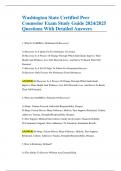Washington State Certified Peer
Counselor Exam Study Guide 2024/2025
Questions With Detailed Answers
1. What Is SAMHSA's Definition Of Recovery?
A) Recovery Is A Quick Fix For Substance Use Issues.
B) Recovery Is A Process Of Change Through Which Individuals Improve Their
Health And Wellness, Live Self-Directed Lives, And Strive To Reach Their Full
Potential.
C) Recovery Is A Set Of Steps To Follow For Guaranteed Success.
D) Recovery Only Focuses On Abstinence From Substances.
ANSWER: B) Recovery Is A Process Of Change Through Which Individuals
Improve Their Health And Wellness, Live Self-Directed Lives, And Strive To Reach
Their Full Potential.
2. What Are SAMHSA's Elements Of Recovery?
A) Hope, Trauma-Focused, Individual Responsibility, Respect.
B) Hope, Person-Driven, Many Pathways, Holistic, Peer Support, Relational, Culture,
Addresses Trauma, Strengths/Responsibility, Respect.
C) Peer Support, Medical Intervention, Family Involvement, Financial Stability.
D) Community Support, Strict Adherence To Treatment, Immediate Results.
ANSWER: B) Hope, Person-Driven, Many Pathways, Holistic, Peer Support,
Relational, Culture, Addresses Trauma, Strengths/Responsibility, Respect.
3. How Is Resiliency Defined?
A) The Ability To Recover Without Any External Help.
,B) The Ability To Adapt Effectively And Recover From Disappointment, Difficulty,
Or Crisis.
C) The Capacity To Avoid Difficulties Entirely.
D) The Strength To Push Through Without Acknowledging Emotions.
ANSWER: B) The Ability To Adapt Effectively And Recover From Disappointment,
Difficulty, Or Crisis.
4. What Are Differing Ideas About Recovery In Substance Use Disorders?
A) Abstinence Vs. Harm Reduction.
B) Treatment Vs. No Treatment.
C) Individual Vs. Group Therapy.
D) Short-Term Vs. Long-Term Care.
ANSWER: A) Abstinence Vs. Harm Reduction.
5. Why Are Families Integral To Recovery For Children?
A) They Provide Financial Support.
B) They Are Advocates, Offer Emotional Support, And Facilitate Environmental
Change.
C) They Enforce Strict Rules And Discipline.
D) They Serve As The Only Source Of Information.
ANSWER: B) They Are Advocates, Offer Emotional Support, And Facilitate
Environmental Change.
6. What Is The Difference Between The Medical Model And The Recovery Model Of
Care?
A) Medical: Focuses Solely On Physical Health; Recovery: Incorporates Mental
Health.
, B) Medical: Languages Are Overly Clinical, Disempowering, And Do Not Promote
Hope; Recovery: Language And Practices That Are Person-Centered And Promote
Hope And Recovery Concepts.
C) Medical: Emphasizes Quick Treatment; Recovery: Encourages Lifelong Change.
D) Medical: Only For Severe Cases; Recovery: Applies To Everyone.
ANSWER: B) Medical: Languages Are Overly Clinical, Disempowering, And Do
Not Promote Hope; Recovery: Language And Practices That Are Person-Centered
And Promote Hope And Recovery Concepts.
7. What Is Person First Language?
A) Describing Individuals By Their Diagnoses.
B) Placing The Individual Ahead Of The Challenge, Emphasizing Strengths And
Individuality.
C) Using Clinical Terms To Define Someone.
D) Avoiding Any Mention Of Challenges.
ANSWER: B) Placing The Individual Ahead Of The Challenge, Emphasizing
Strengths And Individuality.
8. Name Two Ways Peer Supporters Can Support Recovery.
A) Share Their Own Recovery Journey And Impose Their Choices.
B) Inspire Hope And Possibility, Support Peers To Get In Touch With Their Own
Inner Wisdom.
C) Focus On Fixing Peers' Problems And Giving Solutions.
D) Act As Authoritative Figures.
ANSWER: B) Inspire Hope And Possibility, Support Peers To Get In Touch With
Their Own Inner Wisdom.
9. Why Is Hope Essential For Recovery?





